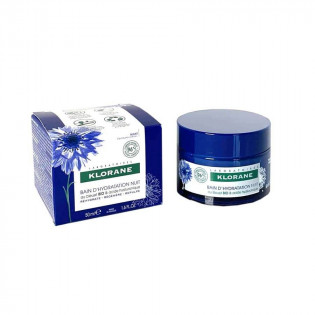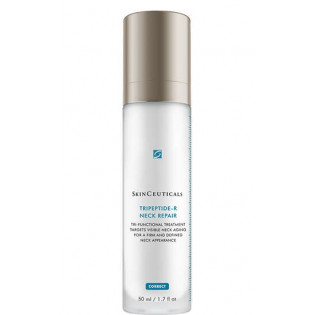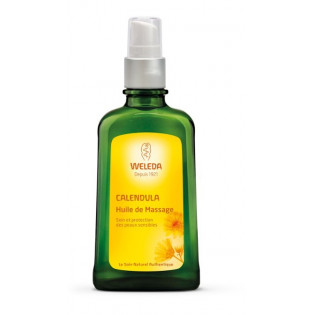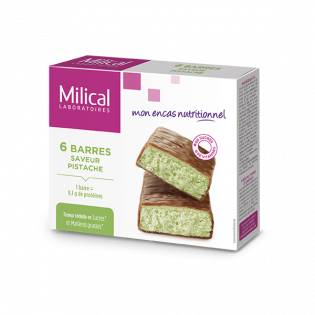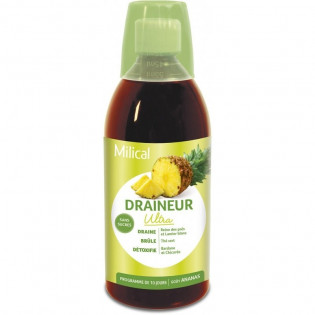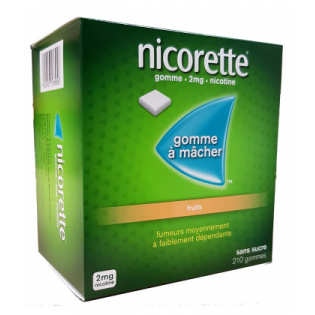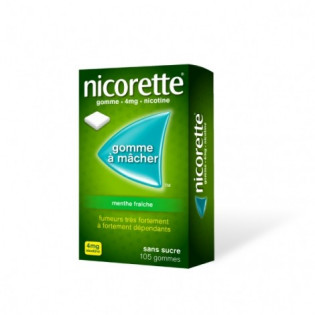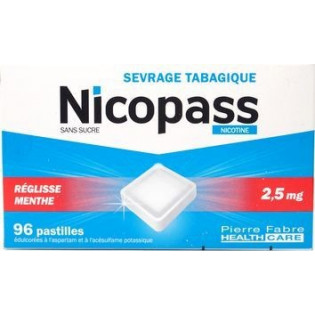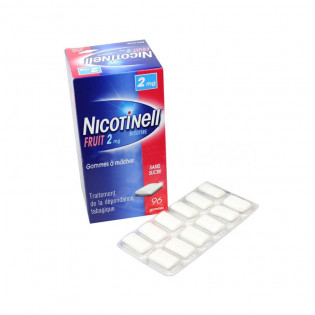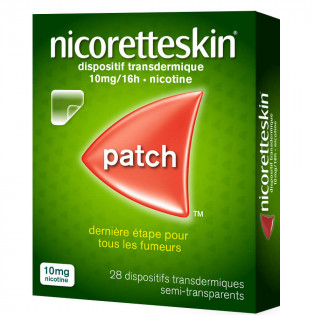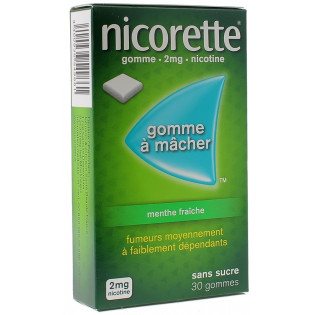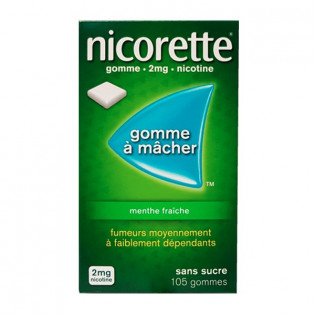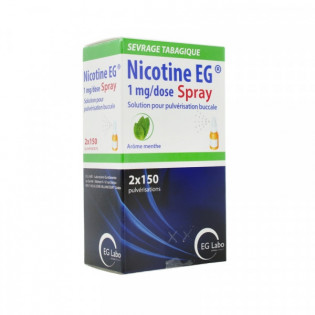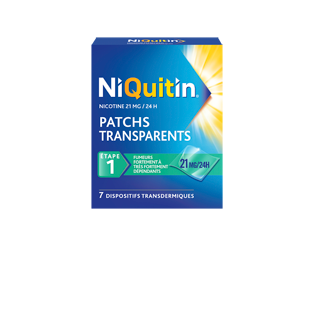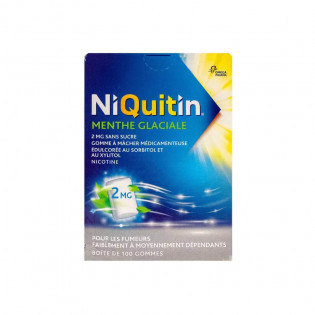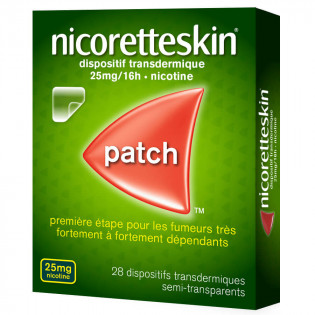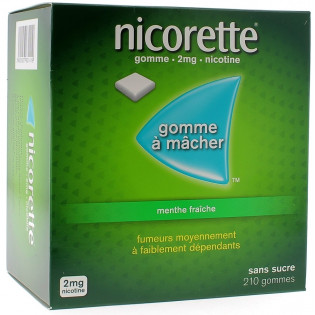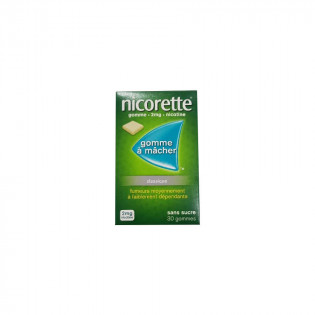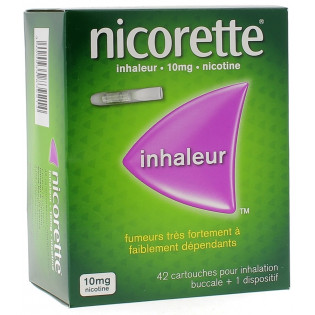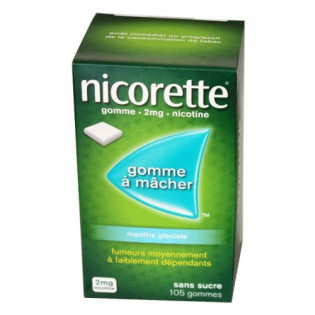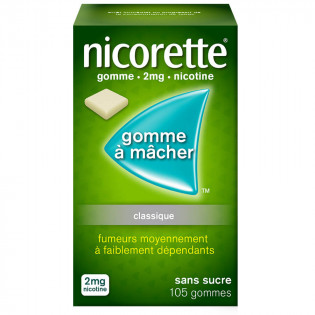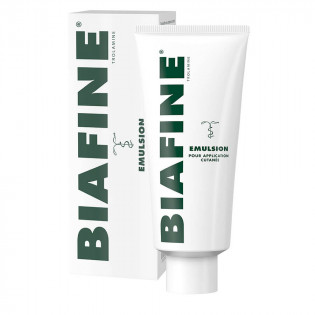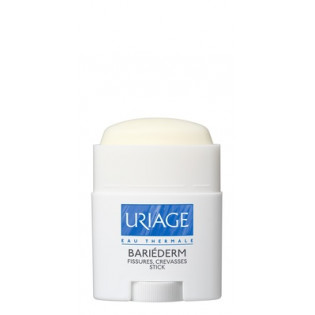In this manual :
1. WHAT IS NICORETTE GLACIAL MINT 2 mg SUGAR-FREE, medicated chewing gum sweetened with xylitol and acesulfame potassium AND WHAT IS IT USED FOR?
2. WHAT YOU SHOULD KNOW BEFORE TAKING NICORETTE GLACIAL MINT 2 mg SUGAR-FREE, medicated chewing gum sweetened with xylitol and acesulfame potassium
3. HOW TO TAKE NICORETTE GLACIAL MINT 2 mg SUGAR-FREE, medicated chewing gum sweetened with xylitol and acesulfame potassium?
4. WHAT ARE THE POSSIBLE SIDE EFFECTS?
5. HOW TO CONSERVE NICORETTE GLACIAL MINT 2 mg SUGAR-FREE, medicated chewing gum sweetened with xylitol and acesulfame potassium?
6. ADDITIONAL INFORMATION
1. WHAT IS NICORETTE GLACIAL MINT 2 mg SUGAR-FREE, medicated chewing gum sweetened with xylitol and acesulfame potassium AND WHAT IS IT USED FOR?
Pharmacotherapeutic class
Drug used in nicotine addiction.
This medicine is indicated for the treatment of tobacco dependence in order to relieve the symptoms of nicotine withdrawal in subjects wishing to stop smoking.
Although permanent cessation of smoking is preferred, this drug may be used in:
- cases where a smoker is temporarily abstaining from smoking,
- a smoking reduction strategy as a step towards permanent cessation.
2. WHAT YOU SHOULD KNOW BEFORE TAKING NICORETTE GLACIAL MINT 2 mg SUGAR-FREE, medicated chewing gum sweetened with xylitol and acesulfame potassium?
List of information needed before taking the medicine
Not applicable.
Do not take NICORETTE GLACIAL MINT 2 mg SUGAR-FREE, medicated chewing gum sweetened with xylitol and acesulfame potassium in the following cases:
IF IN DOUBT, IT IS ESSENTIAL TO ASK YOUR DOCTOR OR PHARMACIST FOR ADVICE.
Precautions for use; special warnings
Take care with NICORETTE GLACIAL MINT 2 mg SUGAR-FREE, medicated chewing gum sweetened with xylitol and acesulfame potassium:
Special Warnings
Some diseases require medical examination and monitoring before using this medicine. Thus, in case of:
- severe liver and/or kidney failure
- an ulcer of the stomach or duodenum in progress.
It is essential to consult your doctor before using this medicine.
It is essential to keep chewing gum out of the reach and sight of children.
Indeed, the therapeutic dose intended for adults could cause serious or even fatal poisoning in children.
Precautions for use
Certain signs indicate an underdose. If you feel, despite the treatment, a sensation of "lack" such as
- an urge to smoke,
- irritability, sleep disorders,
- agitation or impatience,
- difficulty concentrating.
Consult your doctor or pharmacist. It may be necessary to change the dosage of the medication.
Certain signs may indicate an overdose: if signs of overdose appear, i.e:
- nausea, abdominal pain, diarrhea,
- hypersalivation,
- sweating, headache, dizziness, decreased hearing,
- general weakness.
It is imperative to adapt the treatment with the help of your doctor or pharmacist.
This medicine contains 11.4 mg of sodium per chewing gum. To be taken into account in patients controlling their dietary sodium intake.
This medicine contains xylitol and may cause digestive problems (diarrhoea).
If NICORETTE GLACIAL MINT 2 mg Gum is used in combination with a NICORETTE transdermal device, refer to the package insert for each medication.
IF IN DOUBT, DO NOT HESITATE TO ASK YOUR DOCTOR OR PHARMACIST FOR ADVICE.
Interactions with other medicines
Taking or using other medicines
Please tell your doctor or pharmacist if you are taking or have recently taken any other medication, even if it is obtained without a prescription.
Interactions with food and drink
Not applicable.
Interactions with herbal products or alternative therapies
Not applicable.
Use during pregnancy and lactation
Pregnancy and lactation
If you are pregnant or breastfeeding:
|
Ask your doctor or pharmacist for advice before taking any medication.
|
Pregnancy
It is very important to stop smoking during your pregnancy for you and your baby.
Treatment with nicotine replacement products during pregnancy requires medical advice and monitoring. You should therefore consult the health professional who is following your pregnancy or your usual doctor or a doctor in a centre specialising in smoking cessation.
Breastfeeding
If you are a heavy smoker and do not plan to stop smoking, you should not breastfeed your child but use artificial milk.
The use of this medicine should be avoided while breast-feeding, as nicotine passes into breast milk.
However, if you wish to stop smoking and breastfeed your child, take the advice of your doctor or a doctor in a centre specialising in smoking cessation.
Not applicable.
Effects on ability to drive or use machines
Not applicable.
List of excipients with a known effect
List of excipients with a notable effect: xylitol, sodium.
3. HOW TO TAKE NICORETTE GLACIAL MINT 2 mg SUGAR-FREE, medicated chewing gum sweetened with xylitol and acesulfame potassium?
Instructions for proper use
Not applicable.
Dosage, Method and/or route(s) of administration, Frequency of administration and Duration of treatment
For adults only (15 years and older).
Dosage
Chewing gums containing 2 mg of nicotine are not suitable for smokers who are strongly or very strongly dependent on nicotine (Fagerström test score of 7 to 10 or smoking more than 20 cigarettes per day: see Health Education Advice).
Quitting smoking completely
Treatment for nicotine dependence is usually done in 2 phases.
1st phase:
Chew one gum each time you feel like smoking. The number of chewing gums dosed at 2 mg is generally 8 to 12 gums per day and should never exceed 30 gums per day. The duration of this phase is approximately 3 months, but may vary depending on individual response.
2nd phase:
When the urge to smoke is completely overcome, gradually reduce the number of gums chewed per day. Treatment will be stopped when consumption is reduced to 1 to 2 gums per day.
It is recommended not to use the gums beyond 12 months.
If during your treatment you continue to experience cravings or if your treatment has failed, CONSULT YOUR DOCTOR. Your doctor may advise you to combine NICORETTE GLACIAL MINT Gum 2 mg with a form that delivers nicotine throughout the day: NICORETTE transdermal devices.
Temporary abstinence from smoking
Chew a piece of gum every time you feel like smoking.
The number of chewing gums containing 2 mg is generally 8 to 12 gums per day and should never exceed 30 gums per day.
Reducing tobacco consumption
If possible, alternate nicotine gum with cigarettes.
Chew gum as soon as the urge to smoke arises in order to reduce cigarette consumption as much as possible and to remain smoke-free as long as possible.
The number of gums to chew per day varies and depends on your needs. However, it should not exceed 30 gums per day.
If a reduction in cigarette consumption has not been achieved after 6 weeks of treatment, it is recommended to seek advice from a health professional.
The reduction of tobacco consumption should lead you gradually to a complete stop of smoking. This cessation should be attempted as soon as possible within 6 months of starting treatment. If after 9 months of treatment, the attempt to stop smoking completely has failed, it is recommended to seek advice from a health professional.
It is recommended not to use the gums beyond 12 months.
To increase the chances of success in quitting smoking completely, it is important to aim for more than a 50% reduction in consumption during this reduction phase. NICORETTE chewing gums help to achieve this goal before quitting smoking completely.
Mode and route of administration
By mouth.
To be active, the nicotine contained in the gum and released by chewing must be absorbed by the oral mucosa.
If the nicotine is swallowed with saliva, it has no effect. It is therefore important not to chew the gum too vigorously.
Thus, it is advisable to chew the gum once, then keep it against the cheek for about 10 minutes: the gum softens and allows the nicotine to be released gradually, to be absorbed by the oral mucosa, thus passing into the circulation.
Then chew the gum very slowly (about 20 times in 20 minutes).
The gum should be kept in the mouth for about 30 minutes. After 30 minutes, the gum will no longer deliver nicotine.
Duration of treatment
For the complete cessation of smoking:
|
The duration of use is limited to 12 months.
|
In case of persistent cravings or difficulty in quitting, consult your doctor.
Symptoms and instructions in case of overdose
If you have taken more NICORETTE GLACIAL MINT 2 mg SUGAR-FREE, medicated chewing gum sweetened with xylitol and acesulfame potassium than you should have:
In case of accidental overdose or if a child swallows one or more chewing gums: CONTACT A PHYSICIAN OR EMERGENCY SERVICE.
Serious intoxication may occur and may be manifested by hypotension, weak and irregular heartbeat, respiratory distress, prostration, cardiovascular collapse and convulsions.
Instructions in case of missed dose(s)
Not applicable.
Risk of withdrawal syndrome
Not applicable.
4. WHAT ARE THE POSSIBLE SIDE EFFECTS?
Description of adverse reactions
Like all medicines, NICORETTE GLACIAL MINT 2 mg SUGAR-FREE, medicated chewing gum sweetened with xylitol and acesulfame potassium is likely to have undesirable effects, although not everyone is subject to them.
Possible occurrence of headaches, dizziness, nausea, vomiting, digestive disorders, hiccups, sore throat, irritation of the mouth, jaw pain, risk of alteration of the dental apparatus, redness of the skin, urticaria, palpitations.
More rarely, heart rhythm disturbances or allergic reactions may occur.
Dizziness, headaches, sleep disorders, mouth ulcers may be related to stopping smoking and not to your treatment.
If NICORETTE GLACIAL MINT 2 mg Gum is used in combination with NICORETTE Transdermal Device, please refer to the package insert for each medication.
If you notice any side effects not listed in this leaflet, or if any side effects become serious, please tell your doctor or pharmacist.
5. HOW TO USE NICORETTE GLACIAL MINT 2 mg SUGAR-FREE, medicated chewing gum sweetened with xylitol and acesulfame potassium?
Keep out of the reach and sight of children.
Do not use NICORETTE GLACIAL MINT 2 mg SUGAR-FREE, medicated chewing gum sweetened with xylitol and acesulfame potassium after the expiry date stated on the box.
The expiry date refers to the last day of the month.
Store at a temperature not exceeding 25°C.
If necessary, warnings against certain visible signs of deterioration
Do not dispose of medicines in the sewage system or in the household waste. Ask your pharmacist what to do with unused medicines. This will help protect the environment.
6. ADDITIONAL INFORMATION
Full list of active ingredients and excipients
What does NICORETTE GLACIAL MINT 2 mg SUGAR-FREE, medicated chewing gum sweetened with xylitol and acesulfame potassium contain?
The active substance is:
Nicotine .............................................................................................................................................. 2 mg
In the form of nicotine resinate
For a medicated chewing gum.
The other components are:
Chewing gum base, xylitol, peppermint essential oil, anhydrous sodium carbonate, sodium bicarbonate, acesulfame potassium, levomenthol, light magnesium oxide.
Sub-coatingWinterfresh* flavour, hypromellose, sucralose, polysorbate 80.
CoatedSub-coating : xylitol, starch, winterfresh* flavour, titanium dioxide (E171).
*Composition of the winterfresh flavourEssential oil of field mint without terpenes, natural menthol, essential oil of peppermint without terpenes, natural eucalyptol, natural menthone, trans-anethole, sandalwood oil.
Pharmaceutical form and content
What is NICORETTE GLACIAL MINT 2 mg SUGAR-FREE, medicated chewing gum sweetened with xylitol and acesulfame potassium and what is in the pack?
This medicine comes in the form of medicated chewing gum. Box of 10, 12, 15, 20, 24, 30, 36, 40, 45, 90, 96, 105 or 210 chewing gums.
Name and address of the marketing authorisation holder and of the manufacturing authorisation holder responsible for batch release, if different
Holder
JOHNSON & JOHNSON SANTE BEAUTE FRANCE
1, rue Camille Desmoulins
92130 ISSY-LES-MOULINEAUX
Operator
JOHNSON & JOHNSON SANTE BEAUTE FRANCE
1, rue Camille Desmoulins
92130 ISSY-LES-MOULINEAUX
Manufacturer
MCNEIL AB
NORRBROPLATSEN 2
251 09 HELSINGBORG
SWEDEN
Names of the medicinal product in the Member States of the European Economic Area
Not applicable.
Date of approval of the package leaflet
The last date on which this package leaflet was approved was {date}.
MA under exceptional circumstances
Not applicable.
Detailed information on this medicinal product is available on the website of Afssaps (France).
Information reserved for health professionals
Not applicable.
ADVICE / HEALTH EDUCATION
|
Quitting smoking as soon as possible has immediate health benefits. It's never too late to quit smoking, even if you've smoked a lot and for a long time.
|
As soon as you stop smoking:
- You will no longer absorb the irritating and toxic substances of cigarettes,
- You will notice some improvements: gradual disappearance of headaches, coughing, throat irritation, shortness of breath,
- You will often have the satisfaction of finding a better sleep, the taste of food, smells and improve your physical performance,
- You will decrease your risk of developing lung cancer or cardiovascular disease.
Moreover, in heart or arterial diseases (angina pectoris, arteritis of the lower limbs ...), it is particularly imperative to succeed in quitting smoking.
What is tobacco addiction?
Tobacco addiction is twofold:
- Psychological dependence:
Smoking a cigarette leads to a ritual of automatic and repetitive gestures associated with particular circumstances (pleasure, response to stress, intellectual stimulation, support for morale, need for the gesture of conviviality). This is psychological and behavioural dependence.
- Physical dependence:
The body's need for nicotine is due to the effects of this substance on the nervous system. This is called physical dependence. Failure to satisfy this need leads to a feeling of withdrawal (see description in the chapter"How to overcome your physical dependence?").
Nicotine substitutes are designed to treat this dependence.
How to overcome your psychological dependence?
- Quitting smoking completely is necessary to increase your chances of success, but in addition
o Choose a D-day in the period that seems most favorable to you.
o Throw away your last pack of cigarettes, your lighter and put away your ashtrays.
o In a couple of smokers, it is preferable that the quit attempt be made at the same time by both spouses.
- Tell your family and colleagues that you are quitting smoking. Ask them to respect your decision (not to smoke near you, not to offer you any more cigarettes).
- Prepare yourself to face the desire to smoke. It may come on suddenly and intensely, especially during the first few weeks after you stop smoking, but it should not last more than 3 or 4 minutes.
You must plan what you will do in this case and act very quickly so as not to "crack", for example
o drinking a large glass of water,
o Chewing gum,
o count to 100,
o Take a few deep breaths,
o leaving the room,
o Change your activity...
- Avoid situations associated with smoking (coffee, aperitif, etc.), avoid temptations (sit down with non-smokers).
Find compensations for smoking (leisure, sport, cultural activities...).
How to overcome your physical dependence?
If you are addicted to nicotine, the success of your approach may require the use of nicotine substitutes.
In order to evaluate your level of dependence, the Fagerstrom test is proposed to you.
FAGERSTROM TEST
Score from 0 to 2: you are not addicted to nicotine.
You can stop smoking without needing a nicotine substitute.
However, if you are afraid to stop, ask your pharmacist or doctor for advice.
Score of 3 to 4: you are slightly dependent on nicotine.
Score of 5 to 6: you are moderately dependent on nicotine.
The use of nicotine substitutes will increase your chances of success.
Ask your pharmacist or doctor to help you choose the most suitable treatment for you.
Score of 7 to 10: you are strongly or very strongly dependent on nicotine.
The use of nicotine substitutes is recommended to help you overcome your nicotine dependence. This treatment must be used in sufficient and appropriate doses.
Take advice from your pharmacist or your doctor, possibly in the context of a specialised consultation to help you stop smoking.
The problems associated with withdrawal may persist for a long time and the treatment should be of sufficient duration, usually one to three months.
If, despite the treatment, you feel a persistent sensation of "withdrawal" such as
- a strong urge to smoke,
- irritability, sleep disorders,
- agitation or impatience,
- difficulty in concentrating.
Take the advice of your doctor or pharmacist because an adaptation of the doses may be necessary.
How can you get help?
- Support from healthcare professionals
Support from healthcare professionals The support, advice and follow-up that your doctor or pharmacist can provide you with will be invaluable during the first six months of quitting smoking. You can also turn to a specialized smoking cessation consultation, especially if you have already failed.
- Psychological support
Quitting smoking requires a supportive family and social environment. If you are worried that the difficulties are too great, psychological support or temporary treatment can help.
- Diet
In the months following quitting smoking, you may notice a moderate weight gain.
If you have any concerns in this area, you can contact a health professional who will be able to advise you.
Why did you start smoking again?
Consider this relapse as an accident, as a normal event that allows you to learn: a relapse is not a failure.
Analyse the reasons why you started smoking again.
- Because ofphysical dependence
This may have been poorly taken into account or may have reappeared after several months, for example, during prolonged stays in smoky atmospheres.
- Because of a weight gain considered excessive
It will probably be necessary to modify your eating habits a little before your next attempt to stop smoking.
- Because of a drop in motivation, because of a painful event or a difficult period, because of psychological difficulties that have arisen since you stopped smoking (depression, anxiety...), because of a very tempting situation. Understand the reason for this relapse to prevent it if possible during the next attempt.
In all cases, don't hesitate to ask for advice from a health professional or to go to a specialized smoking cessation consultation.
|
If you have started smoking again, don't be discouraged, experience shows that your chances of success increase after one or more attempts to quit.
|
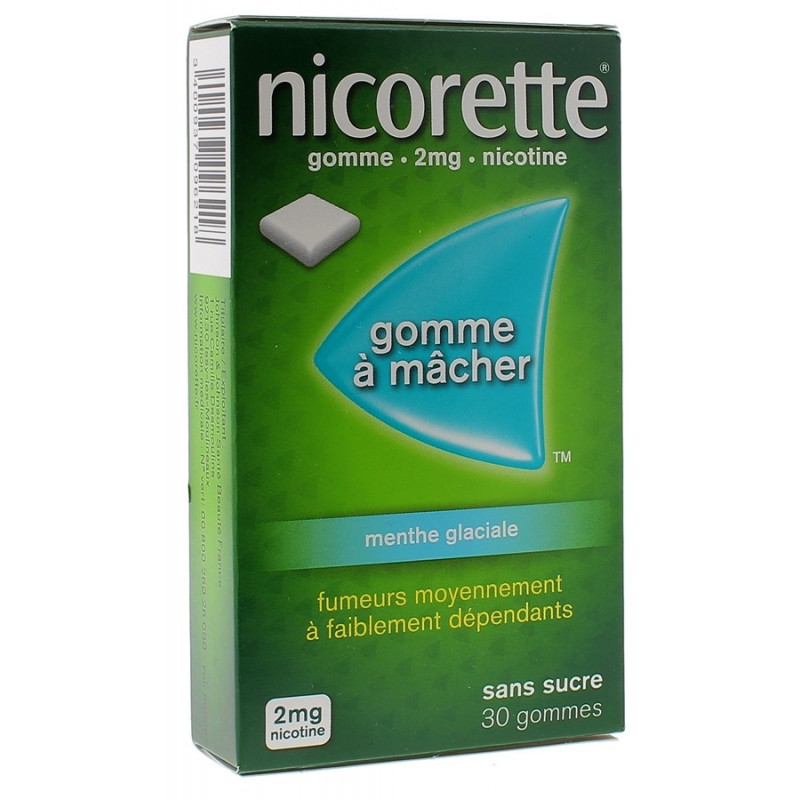
 Français
Français English
English
